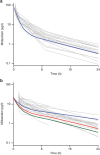Integration of in vitro binding mechanism into the semiphysiologically based pharmacokinetic interaction model between ketoconazole and midazolam
- PMID: 24448021
- PMCID: PMC4026634
- DOI: 10.1038/psp.2013.50
Integration of in vitro binding mechanism into the semiphysiologically based pharmacokinetic interaction model between ketoconazole and midazolam
Abstract
In vitro screening for drug-drug interactions is an integral component of drug development, with larger emphasis now placed on the use of in vitro parameters to predict clinical inhibition. However, large variability exists in Ki reported for ketoconazole with midazolam, a model inhibitor-substrate pair for CYP3A. We reviewed the literature and extracted Ki for ketoconazole as measured by the inhibition of hydroxymidazolam formation in human liver microsomes. The superset of data collected was analyzed for the impact of microsomal binding, using Langmuir and phase equilibrium binding models, and fitted to various inhibition models: competitive, noncompetitive, and mixed. A mixed inhibition model with binding corrected by an independent binding model was best able to fit the data (Kic = 19.2 nmol/l and Kin = 39.8 nmol/l) and to predict clinical effect of ketoconazole on midazolam area under the concentration-time curve. The variability of reported Ki may partially be explained by microsomal binding and choice of inhibition model.
Figures



Similar articles
-
Inhibition of cytochrome P-450 3A (CYP3A) in human intestinal and liver microsomes: comparison of Ki values and impact of CYP3A5 expression.Drug Metab Dispos. 1999 Feb;27(2):180-7. Drug Metab Dispos. 1999. PMID: 9929500
-
Midazolam alpha-hydroxylation by human liver microsomes in vitro: inhibition by calcium channel blockers, itraconazole and ketoconazole.Pharmacol Toxicol. 1999 Oct;85(4):157-61. doi: 10.1111/j.1600-0773.1999.tb00085.x. Pharmacol Toxicol. 1999. PMID: 10563513
-
Pharmacokinetic Interactions of Rolapitant With Cytochrome P450 3A Substrates in Healthy Subjects.J Clin Pharmacol. 2019 Apr;59(4):488-499. doi: 10.1002/jcph.1339. Epub 2018 Nov 13. J Clin Pharmacol. 2019. PMID: 30422319 Clinical Trial.
-
Sources of variability in ketoconazole inhibition of human cytochrome P450 3A in vitro.Xenobiotica. 2010 Oct;40(10):713-20. doi: 10.3109/00498254.2010.506224. Xenobiotica. 2010. PMID: 20712450 Review.
-
Ritonavir is the best alternative to ketoconazole as an index inhibitor of cytochrome P450-3A in drug-drug interaction studies.Br J Clin Pharmacol. 2015 Sep;80(3):342-50. doi: 10.1111/bcp.12668. Epub 2015 Jun 1. Br J Clin Pharmacol. 2015. PMID: 25923589 Free PMC article. Review.
Cited by
-
Towards the Elucidation of the Pharmacokinetics of Voriconazole: A Quantitative Characterization of Its Metabolism.Pharmaceutics. 2022 Feb 22;14(3):477. doi: 10.3390/pharmaceutics14030477. Pharmaceutics. 2022. PMID: 35335853 Free PMC article.
-
Optimizing enzyme inhibition analysis: precise estimation with a single inhibitor concentration.Nat Commun. 2025 Jun 5;16(1):5217. doi: 10.1038/s41467-025-60468-z. Nat Commun. 2025. PMID: 40473596 Free PMC article.
References
-
- FDA. Draft Guidance for Industry Drug Interaction Studies – Study Design, Data Analysis, and Implications for Dosing, and Labeling Recommendations. 2012.
-
- Hallifax D., Houston J.B. Methodological uncertainty in quantitative prediction of human hepatic clearance from in vitro experimental systems. Curr. Drug Metab. 2009;10:307–321. - PubMed
-
- Tran T.H., et al. Microsomal protein concentration modifies the apparent inhibitory potency of CYP3A inhibitors. Drug Metab. Dispos. 2002;30:1441–1445. - PubMed
-
- Austin R.P., Barton P., Cockroft S.L., Wenlock M.C., Riley R.J. The influence of nonspecific microsomal binding on apparent intrinsic clearance, and its prediction from physicochemical properties. Drug Metab. Dispos. 2002;30:1497–1503. - PubMed
Grants and funding
LinkOut - more resources
Full Text Sources
Other Literature Sources

